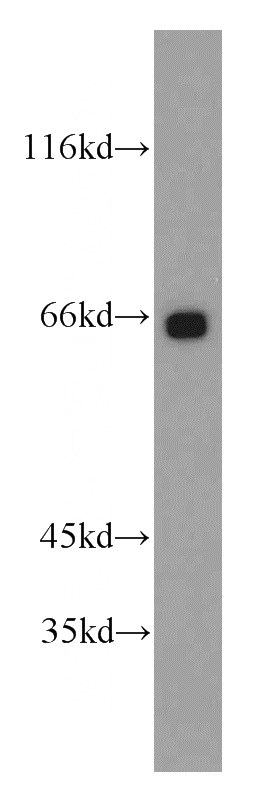-
Product Name
BBS6 antibody
- Documents
-
Description
BBS6 Rabbit Polyclonal antibody. Positive IF detected in hTERT-RPE1 cells. Positive WB detected in mouse testis tissue, mouse brain tissue. Observed molecular weight by Western-blot: 63kd
-
Tested applications
ELISA, WB, IF
-
Species reactivity
Human,Mouse,Rat; other species not tested.
-
Alternative names
BBS6 antibody; HMCS antibody; KMS antibody; McKusick Kaufman syndrome antibody; MKKS antibody; MKS antibody
-
Isotype
Rabbit IgG
-
Preparation
This antibody was obtained by immunization of BBS6 recombinant protein (Accession Number: NM_018848). Purification method: Antigen affinity purified.
-
Clonality
Polyclonal
-
Formulation
PBS with 0.02% sodium azide and 50% glycerol pH 7.3.
-
Storage instructions
Store at -20℃. DO NOT ALIQUOT
-
Applications
Recommended Dilution:
WB: 1:200-1:1000
IF: 1:20-1:200
-
Validations

IF result (cytoplasm and the base of cilia stain) of anti-BBS6 (Catalog No:108373; 1:50) with hTERT-RPE1 cell (MeOH fixed) by Dr. Moshe Kim.

mouse testis tissue were subjected to SDS PAGE followed by western blot with Catalog No:108373(BBS6 antibody) at dilution of 1:600
-
Background
MKKS also known as BBS6 is a probable chaperone given to the amino acid similarity to the chaperonin family of proteins and may play a role in protein processing in limb, cardiac and reproductive system development. The mutations in BBS6 have been linked to Bardet-Biedl syndrome (BBS) which is a genetically heterogeneous, autosomal recessive disorder characterized by usually severe pigmentary retinopathy, early onset obesity, polydactyly, hypogenitalism, renal malformation and mental retardation. It may also get involved in cellular organization processes, in particular relating to ciliary/flagellar and centrosomal activities.
Related Products / Services
Please note: All products are "FOR RESEARCH USE ONLY AND ARE NOT INTENDED FOR DIAGNOSTIC OR THERAPEUTIC USE"
